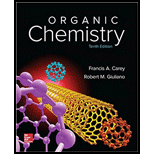
Concept explainers
Interpretation:
The configuration of the chirality center as R or S is to be determined for the given compounds.
Concept introduction:
If a tetrahedral carbon is attached to four different atoms or groups, then such carbon is called a chiral carbon or chiral center.
The three-dimensional spatial arrangement of substituents at a chirality center is called the absolute configuration.
The Cahn-Ingold-Prelog rule system ranks the substituents in the chirality center in the order of decreasing atomic number. The higher atomic number takes precedence over the lower atomic number.
When two or more of the atoms directly bonded to the chirality center are same, compare the atoms bonded to the chirality center on the basis of their
Work outward direction from the point of attachment by comparing all the atoms attached to a particular atom before continuing further along the chain.
When working outward direction from the point of attachment, always estimate substituent atoms one by one, never as a group.
After the substituents at the chiral center are ranked with decreasing priority order, the next step is to orient the molecule so that the bond to the lowest ranked substituent points away from the observer. This is used to determine if the sequence of decreasing priority of the other three substituents is clockwise or counterclockwise. If this path is clockwise, then the configuration is R, and if it is counterclockwise, the configuration is S.
Trending nowThis is a popular solution!

Chapter 4 Solutions
ORGANIC CHEMISTRY (LOOSELEAF)-PACKAGE
- Please answer the question for the reactions, thank youarrow_forwardWhat is the product of the following reaction? Please include a detailed explanation of what is happening in this question. Include a drawing showing how the reagent is reacting with the catalyst to produce the correct product. The correct answer is IV.arrow_forwardPlease complete the reactions, thank youarrow_forward
- Consider the synthesis. What is compound Y? Please explain what is happening in this question. Provide a detailed explanation and a drawing to show how the compound Y creates the product. The correct answer is D.arrow_forwardWhat would be the major product of the following reaction? Please include a detailed explanation of what is happening in this question. Include steps and a drawing to show this reaction proceeds and how the final product is formed. The correct answer is B. I put answer D and I don't really understand what is going on in the question.arrow_forwardWhat is the product of the following reaction? Please explain what is happening in this question. Provide a detailed explanation and a drawing showing how the reagent is reacting with the catalysts to product the correct product. The correct answer is B.arrow_forward
- What is the missing intermediate 1 and the final product 2. Please include a detailed explanation explaining the steps of malonic ester synthesis. Please include drawings of the intermediate and how it occurs and how the final product is former.arrow_forwardWhat would be the reagents and conditions above and below the arrow that will complete the proposed acetoacetic ester synthesis? If it cannot be done efficiently, then I will choose that answer. There could be 2 or 4 reagents involved. Please provide a detailed explanation and drawings showing how it would proceed with the correct reagents.arrow_forwardFor benzene, the ∆H° of vaporization is 30.72 kJ/mol and the ∆S° of vaporization is 86.97 J/mol・K. At 1.00 atm and 228.0 K, what is the ∆G° of vaporization for benzene, in kJ/mol?arrow_forward
- The reaction Q(g) + R(g) → Z(l) is shown to be exothermic. Which of the following is true concerning the reaction. it is spontaneous only at High T, it is spontaneous at low T it is nonspontaneous at all T it is spontanrous at all T. it is non spontaneous only at low T.arrow_forwardThe reaction Q(g) + R(g) → Z(l) is shown to be exothermic. Which of the following is true concerning the reactionarrow_forwardWhich of the following has the largest standard molar entropy, S° (298.15 K) He H2 NaCl KBr Hgarrow_forward
 Organic Chemistry: A Guided InquiryChemistryISBN:9780618974122Author:Andrei StraumanisPublisher:Cengage Learning
Organic Chemistry: A Guided InquiryChemistryISBN:9780618974122Author:Andrei StraumanisPublisher:Cengage Learning
